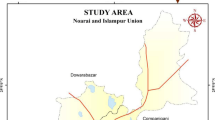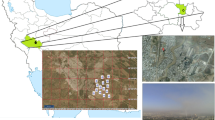Abstract
Cement’s dust particles contamination on soil has received a good amount of attention due to toxicity persistence in the environment. It must be noted that cement dust falls are enriched in toxic heavy metals, which can spread throughout a large area by wind and rain then accumulate on plants, animals, and soils, thus ultimately affecting human health. For this purpose, a study was achieved to evaluate the potential accumulation and spatial distribution of heavy metals in topsoils surrounding the Meftah cement factory, situated at the southeastern of Algiers region. Sixty six soil samples were collected following six directions (east, northeast, north, northwest, west, and southwest) from cement factory on a radius of 3.5 km approximately. The physicochemical parameters, such as the pH, the conductivity, and the organic matter of these samples were determined. The concentration of the Cd, Cu, Pb, and Zn elements, in soil samples, were determined with flame atomic absorption spectrophotometry (FAAS) method and the data generated were analyzed statistically. Thus, the enrichment factor (EF), pollution index (PI), contamination factor (CF), pollution load index (PLI), geoaccumulation index (Igeo), and principal component analysis (PCA) was performed to the dataset in order to calculate and estimate the enrichment of metal concentrations in soils. Moreover, mapping of the spatial distribution of heavy metals was carried out using geographic information system (GIS), to determine more polluted areas and accomplish the objectives of the study. The results of our analysis indicate that soils were polluted most significantly by metals such as lead, zinc, copper, and cadmium. It is thus important to keep systematic and continuous monitoring of the bag filter to reduce the cement dust emission. As possible, remediation activities be carried out on the soil of heavy metals and their derivatives to manage and suppress such pollution.








Similar content being viewed by others
References
Achternbosch M, Brautigam KR, Hartlieb N, Kupsch R, Richers U, Stemmermann P (2003) Heavy metals in cement and concrete resulting from the co-incineration of wastes in cement kilns with regard to the legitimacy of waste utilization. Mitglied der Hermann vonn Helmholtz–Gemeinschaft Deutscher For schungszentren, ISSN 0947–8620: 22–23
Addo MA, Darko EO, Gordon C, Nyarko BJB, Gbadago LJK, Nyarko E (2012) Evaluation of heavy metals contamination of soil and vegetation in the vicinity of a cement factory in the Volta Region, Ghana. IJST 2(1):40–50
Ahiamadjie H, Adukpo OK, Tandoh JB, Gyampo O, Nyarku M, Mumuni II, Agyemang O, Ackah M, Dampare SB (2011) Determination of the elemental contents in soils around diamond cement factory, Aflao. Res J Environ Earth Sci 3(1):46–50
Al-Khashman OA, Shawabkeh RA (2006) Metals distribution in soils around the cement factory in southern Jordan. Environ Pollut 140:387–394
Baby S, Singh NA, Shrivastava P, Nath SR, Kumar SS, Singh D, Vivek K (2008) Impact of dust emission on plant vegetation of vicinity of cement plant. Environ Eng Manag J 7(1):31–35
Bayhan YK, Yapici S, Kocaman B, Nuhoglu A, Cakici A (2002) The effect of cement dust on some soil characteristics. Fresenius Environ Bull 11:1030–1033
Chen Z (1998) Management of contaminated soil remediation programmes. Land Contam Reclam 6:41–56
CPCB (Central Pollution Control Board) (2007) Assessment of fugitive emissions and development of environmental guidelines for control of fugitive emissions in cement manufacturing industries—programme objective series—probes 118/2007. Delhi, India: 34–110
Emmanuel E, Pierre MG, Perrodin Y (2009) Groundwater contamination by microbiological and chemical substances released from hospital wastewater: health risk assessment for drinking water consumers. Environ Int 35:718–726
Estifanos S (2014) Investigating the distribution of selected major and trace metals in lithogenic environment near cement factory, Mekelle, Ethiopia. J Environ Prot 5(2):12
Ghannem N, Gargouri D, Sarbeji MM, Yaich C, Azri C (2014) Metal contamination of surface sediments of the Sfax-Chebba coastal line. Tunisia. Environ Earth Sci 72(9):3419–3427
Hakanson L (1980) Ecological risk index for aquatic pollution control, a sedimentological approach. Water Resour J 14:975–1001
Hindy KT, Abdel Shafy HT, Farag SA (1990) The role of the cement industry in the contamination of air, water, soil and plant with vanadium in Cairo. Environ Pollut 66:195–205
Iqbal MZ, Shafug M (2001) Periodical effect of cement dust pollution on the growth of some plant species. Turk J Bot 25:19–24
Kabir E, Ray S, Kim KH, Yoon HO, Jeon EC, Kim YS, Cho YS, Yun ST, Brown RJC (2012) Current status of trace metal pollution in soils affected by industrial activities. Sci World J Article ID 916705. 18 pages.
Kimbrough DE, Wakakuwa JR (1989) Acid digestion for sediments, sludges, soils, and solid wastes. A proposed alternative to EPA SW 846 method 3050. Environ Sci Technol 23(7):898–900
Krzaklewski W, Barszcz J, Malek S, Koziol K, Pietrzykowski M (2004) Contamination of forest soils in the vicinity of the sedimentation pond after zinc and lead ore flotation (in the region of Olkusz, southern Poland). Water Air Soil Pollut 159:151–164
Mahmood A, Malik RN (2014) Human health risk assessment of heavy metals via consumption of contaminated vegetables collected from different irrigation sources in Lahore, Pakistan. Arab J Chem 7:91–99
Muller G (1969) Index of geo-accumulation in sediments of the Rhine River. Geo J 1969(2):108–118. Int J Environ Sci Technol 5(1):125–134
Ogukunle CO, Fatoba AAAPO (2013) Influence of cement dust pollution on leaf epidermal features of Pennisetum purpureum and Sida acuta. Env Exp Biol 11:73–79
Omotoso OA, Ojo OJ (2015) Assessment of some heavy metals contamination in the soil of river Niger floodplain at Jebba, central Nigeria. Water Util J 9:71–80
Page A (1982) Methods of soil analysis. Soil science society of America, Wisconsin
Saidani N (2014) Etude de la distribution des éléments traces métalliques dans les sols agricoles aux alentours de la cimenterie de Meftah—ENSA Alger 74p
Schuhmacher M, Nadal M, Domingo JL (2009) Environmental monitoring of PCDD/Fs and metals in the vicinity of a cement plant after using sewage sludge as a secondary fuel. Chemosphere 74:1502–1508
Sing VS, Pandey DN (2011) Human health risk due to cement dust exposure policy-brief Climate change and CDM cell. Rajasthan State—Pollution Control Board, Jaipur, pp 1–19
Solgi E (2015) An investigation on Cd And Pb concentrations of soils around the Kurdistan cement factory in Western Iran. J Chem Health Risks 5(3):179–191
Sposito G (2008) The chemistry of soil, 2nd edn. Oxford University Press, New York 234p
Stern AC (1976) Air pollution measurement, monitoring and surveillance of air pollution, 3rd edn. Academic Press, New York
Thabet AM, Mohamed AKM, Ragab R, Mahmoud AG (2014) Application of pollution indices for evaluation of heavy metals in soil close to phosphate fertilizer plant, vol 17. Egypt Assiut University Bulletin for Environmental Researches, Assiut No. 1
Thomilson DC, Wilson DJ, Harris CR, Jeffrey DW (1980) Problem in heavy metals in estuaries and the formation of pollution index. Helgol Wiss Meeresunlter 33(1–4):566–575
Vauclin M, Viera SR, Vachand G, Nielsen DR (1983) The use of C0-Kriging with limited field data. Soil Sci Soc Am J 47(2):175–184
Zerrouqi Z, Sbaa M, Oujidi M, Elkharmouz M, Bengamra S, Zerrouqi A (2008) Assessment of cement’s dust impact on the soil using principal component analysis and GIS. Int J Environ Sci Technol 5(1):125–134
Zhou QX, Song YF (2004) Remediation of contaminated soils: principles and methods. Science Press, Beijing
Acknowledgements
This research was partially supported by LMMA-FSTGAT-USTHB.
Author information
Authors and Affiliations
Corresponding author
Ethics declarations
Conflict of interest
The authors declare that there is no conflict of interest.
Additional information
This article is part of the Topical Collection on Current Advances in Geology of North Africa
Rights and permissions
About this article
Cite this article
Ameraoui, S., Boutaleb, A., Souiher, N. et al. Investigation of potential accumulation and spatial distribution of heavy metals in topsoil surrounding the cement plant of Meftah (southeastern Algiers region, Algeria). Arab J Geosci 10, 464 (2017). https://doi.org/10.1007/s12517-017-3245-0
Received:
Accepted:
Published:
DOI: https://doi.org/10.1007/s12517-017-3245-0




